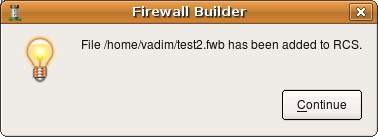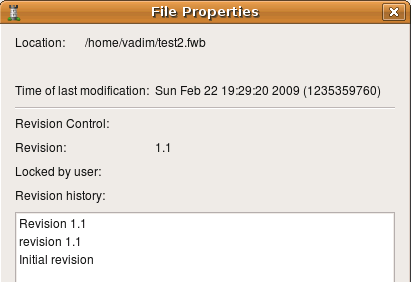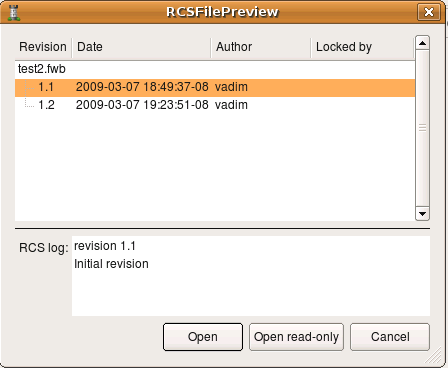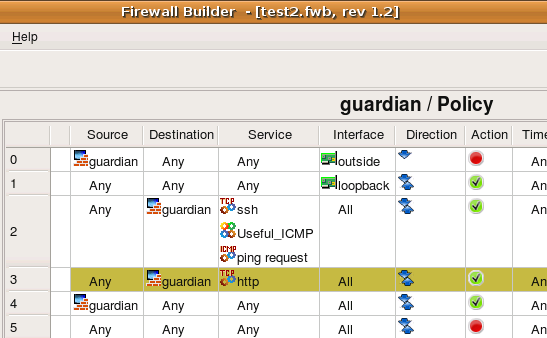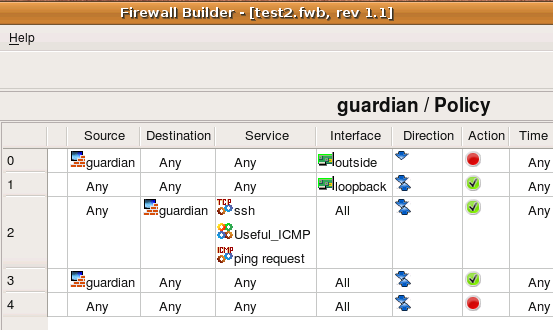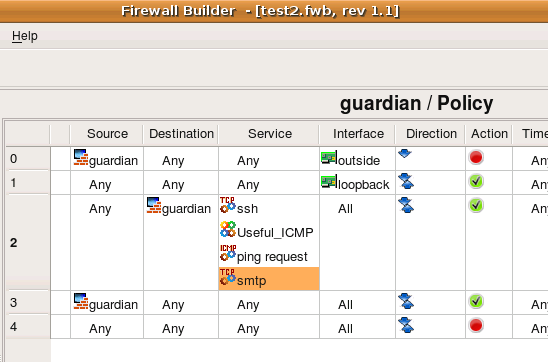Search Users Guide
Note
Linux and *BSD users must install RCS before using revision control in Firewall Builder.
Firewall Builder GUI has built-in revision control system that can be used to keep track of changes in the objects and policy rules. If a data file has been added to the revision control system, every time it is saved, the system asks the user to enter a comment that describes changes done in the file in this session and stores it along with the data. The program also assigns new revision number to the data file using standard software versioning system with major and minor version numbers separated by a dot. When you open this data file next time, the program presents a list of revisions alongside with dates and comments, letting you choose which revision you want to use. You can open the latest revision and continue working with the file from the point where you left off last time, or open one of the older revisions to inspect how the configuration looked like in the past and possibly create a branch in the revision control system. Here we take a closer look at the built-in revision control system.
We start with a regular data file which we open in the Firewall Builder GUI as usual. Note that the name of the file appears in the title bar of the main window, here it is test2.fwb:
You can always see additional information about the file using main menu File/Properties. There is not much the program can report about this file that we do not know already. It shows full path where it is located on the file system and the date and time of last modification, but otherwise since it has not been added to the revision control system, there is no additional information it can report.
To start tracking revisions of this data file, use menu , the program creates all necessary files and reports result in a pop-up dialog. If for some reason adding file to the revision control has failed, the program reports error in the same pop-up dialog. Section 15.6 has a list of typical problems that may occur at this point.
A few things have changed in the GUI after the file has been added to the revision control system. First, in addition to the file name, the title bar now also shows its revision. The initial revision number after checkin is 1.1.
The File/Properties dialog shows that the file is now being tracked by the revision control system and that its current revision is 1.1. There is only one revision in the history and the comment is "Initial revision", which is added automatically by the program.
Let's see how the revision control system keeps track of the changes in the data file. To demonstrate this, we are going to make a change in one of the objects, save the object file and check it in (this creates new revision). Then we'll close the object file. Then, we'll open both revisions to see the differences.
Here is the rule set of the new firewall. It is very simple and consists of just five rules:
Now we add one more rule (to permit HTTP to the firewall). This is rule #3; it is colored yellow:
Now we save this file using and exit the program. Before we can do that, however, the program tries to check the file in to the RCS and presents a dialog where we can add a comment to document the change we made. We enter the comment and click to complete the operation. The file is now checked in and the program exits.
Now we restart the program and open the same file using . Since the file is now in revision control, the program presents the dialog with the list of its revisions. Each revision has a comment associated with it, shown at the bottom of the dialog. Note also that each revision also shows the user name of the user who checked it in, which is very useful in a multi-user environment.
If we choose revision 1.2 (the latest) and click , we see the rule that permits HTTP to the firewall:
If we choose revision 1.1 and open the file, we get this policy (note revision number in the main window title bar, it is 1.1):
The rule to permit HTTP to the firewall is not there because we opened the earlier revision of the data file. Essentially, we rolled back the change we made in rev 1.2. If we only opened the earlier file to take a quick look, we can now just close the file, then open the latest version to continue working. However, if we wanted, we could compile and install the old revision. Note that this can break things if some protocols were added to the firewall rules later, but this can be useful if you need to test things as they were few days ago.
However, if we want to roll back the change and continue without it, all we need to do is make the change in this revision (1.1) and then save and check it in. This will create a branch in RCS and we will be able to continue working with it later. The previous change, checked in as rev 1.2 will always be there, and we will always be able to revert to it if we want. The program does not merge branches, merging changes in XML files is a complex task and is not implemented at this time.
To illustrate creation of a branch, we are making a change to the revision 1.1 of the data file as shown on the next screenshot:
We then save and check this file in with an appropriate comment. To check it in we use . We then close the file using and reopen it again using . This accomplishes the same operation as in the example above in this document, except we do not close the program. When we try to open it, the program shows the branch and new revision 1.1.1.1 that we just created. Note that the time of the revision 1.1.1.1 is later than the time of revision 1.2:
Now if we open rev 1.1.1.1, continue working with and check new changes in, the program will create revision 1.1.1.2 and so on.
This section demonstrates how the built-in revision control system in Firewall Builder GUI can be used to document changes in the file. It can also be used to roll back changes to a previous revision both temporary or permanently. Using RCS helps establish accountability if several administrators can make changes to the policy of firewalls because RCS keeps track of the user name of the user who checked changes in. RCS in Firewall Builder works on all supported OS, that is Linux, FreeBSD, OpenBSD, Windows and Mac OS X. On Linux, *BSD and Mac OS X it relies on system-wide installed rcs package, while on Windows rcs tools are installed as part of the Firewall Builder package. In general, it's useful to always use revision control even in simple cases when only one administrator uses the tool. The ability to document changes and roll back if necessary greatly improves the process of security policy management.
Copyright © 2000-2012 NetCitadel, Inc. All rights reserved.
Using free CSS Templates.




